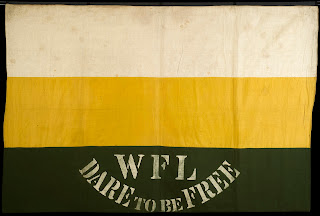So it was very exciting to discover evidence of one suffragette’s “after life” when I recently added a postcard written by Theresa Garnett in 1954 to my collection.
Theresa Garnett wrote the postcard from Elsinore, Denmark on 2 August 1954 to Norah Bowles at the News Chronicle newspaper at its London offices in Bouverie Street. The postcard depicted a map of Denmark. It was addressed “c/o International Alliance of Women, Folk High School, Elsinore, Denmark”.
The card was sent to ask a favour of Norah. It was, Theresa explained, impossible to get hold of English newspapers, and she asked Norah to arrange for copies of the News Chronicle to be sent to her. She added that she was unable to send money from Denmark, but would pay on her return, which would be in a month’s time.
The message ends, “The press here have got hold of
the fact that the suffragette ‘who beat Win C’ is here and are trying to catch
me!” 
"Win C": Winston Churchill
Unfortunately, I can’t show you any images of Theresa Garnett's postcard as I believe it is still in copyright (to Kaj Brammers, b. 1892, who ran a bookstore, paper, music and photo shop in Elsinore, which he was still running in his seventies).
Leeds-born Theresa Garnett’s (1888–1966) militant career as a member of the Women’s Social and Political Union (WSPU) had included chaining herself to a statue in the lobby of the House of Commons, window breaking in Whitehall, and a roof top protest in Liverpool. In November 1909 she carried out her most notorious action when she attacked Winston Churchill with a dog whip at Bristol Temple Meads railway station. She spent a month in Horfield gaol where she went on hunger strike and was forcibly fed. She protested by breaking the glass over the gas light in her cell and setting fire to her pillow and mattress. She ended up in the prison hospital after she collapsed while confined in the punishment cell.
However, by 1910 Theresa had decided that militancy had gone far enough for her and she left the WSPU. She does not seem to have engaged in any further suffrage campaigning. During the First World War she worked as a nurse in London and at the front. After the Second World War she joined the Suffragette Fellowship and the Women’s Freedom League, where she edited the League’s Bulletin. And, as we have seen, she was a member of the International Alliance of Women.
The International Alliance of Women was founded in 1902 in Washington as the International Alliance of Women for Suffrage and Legal Citizenship. In 1904 it became the International Woman Suffrage Alliance (IWSA). At a meeting in Paris in 1926 it changed name again to become the International Alliance of Women for Suffrage and Equal Citizenship. In 1946 the organisation became the International Alliance of Women, by which name it still operates and continues its work for women and girls, focussing on such issues as peace, equality, and sexual and reproductive health rights.
The Elsinore Folk High School was associated with the Danish Folk High School (DFHS) movement. This movement originated in Denmark in the nineteenth century as a means of educating those who could not afford a university education. Its aim was to enable them to take their place in their nation’s political and social life. Students attended residential courses on subjects such as history, civics, politics, art and literature. The emphasis was on learning, and there were no examinations. The DFHS ideals spread to other Nordic countries and has since become a global movement.
I haven’t been able to find out why the IAW was at the Folk High School in Elsinore in August 1954, nor what Theresa Garnett’s role was. However, the Folk High School courses attracted individuals and groups from Britain, as well as being involved in school or youth exchanges. Theresa Garnett had trained as a teacher, and it’s possible that she still took an interest in educational issues. In addition, the DFHS’s emphasis on training for citizenship is likely to have resonated with the IAW. The IAW records are in the Women’s Library at the London School of Economics, so perhaps one day I’ll be able to visit again and investigate further.
I haven’t been able to discover anything about Norah Bowles either, so I don’t know what her job was at the News Chronicle. The newspaper originated in 1930 with the merger of the left-Liberal Daily Chronicle and the Liberal Daily News, which was originally edited by Charles Dickens and later owned by the Quaker George Cadbury. The News Chronicle ceased publication in 1960.
So Theresa Garnett’s postcard has raised a number of questions – not least of which is: why would the Danish press be interested in something that happened forty-five years earlier? Undoubtedly, one reason is that Winston Churchill was the British Prime Minister, the Conservatives having been returned to power in 1951. Clearly Theresa Garnett’s suffragette experiences still had significance to her and others. Even as new interests had taken the place of the suffrage campaign, she was mindful of her status – or notoriety – as “the suffragette ‘who beat Win C’ ”. Though the British women’s suffrage campaign was long over, it echoed and resonated down the years and was an integral part of the “after life” of Theresa Garnett and other suffragettes.
Picture Credits
Winston Churchill c 1907: Postcard, Author's Collection. Photograph is by Reginald Haines (1872-1942)
Women's Freedom League Banner: Women's Library on Flickr, No Known Copyright Restrictions
Find out more:-
International Alliance of Women https://womenalliance.org/
Danish Folk High Schools https://www.danishfolkhighschools.com
The News Chronicle https://spartacus-educational.com/JchronicleD.htm and https://spartacus-educational.com/Jnews.htm


Comments
Post a Comment